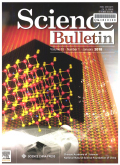- 钛学术文献服务平台 \
- 学术期刊 \
- 基础科学期刊 \
- 自然科学总论期刊 \
- 科学通报(英文版)期刊 \
Magnetic properties of surface soils across the southern Tarim Basin and their relationship with climate and source materials
Magnetic properties of surface soils across the southern Tarim Basin and their relationship with climate and source materials
基本信息来源于合作网站,原文需代理用户跳转至来源网站获取
摘要:
The magnetic susceptibility (χ) of surface soils on the Chinese Loess Plateau (CLP) has strong positive correlation with mean annual precipitation.It is widely accepted that ultrafine magnetite/maghemite grains produced during pedogenesis are responsible for the enhancement of χ,and loess χ on the CLP has been widely used as a proxy for the intensity of the East Asian summer monsoon.However,few works have investigated mechanisms for the enhancement of χ in the case of surface aeolian sediments in westerly-dominated inland China,north of the Tibetan Plateau.Here detailed rock magnetism and grain size studies of 49 surface samples taken across the southern Tarim Basin for different rainfall/temperature/altitude conditions are presented.The results show that samples taken from desert have the lowest χ values and that χ of loessic sand and loess samples decreases with increasing altitude.In addition,the rock magnetism studies suggest that the magnetic properties of surface soils across the southern Tarim Basin are mainly controlled by the concentration of coarse aeolian ferrimagnetic minerals.The contribution of ultrafine pedogenically produced magnetic grains to χ is very limited.

推荐文章
The contribution of bacteria to organic matter in coal-measure source rocks
Coal-measure source rocks
Organic matter type
Bacteria
Monomethyl alkanes
Alkyl cyclohexane
Magnetic Influences of Cement Dust on Soil in Industrial Area and Its Environmental Implications
Cement dust
Soil
Magnetic property
Environmental significance
The influence of climate and topography on chemical weathering of granitic regoliths in the monsoon
Granitic regolith
Chemical weathering
Supply-limited weathering
Kinetic-limited weathering
Characteristics of heavy metals in soils under different land use in a typical karst area, Southwest
Heavy metals
Soil organic carbon
Land use
Karst
Southwest China
内容分析
关键词云
关键词热度
相关文献总数
(/次)
(/年)
引文网络
引文网络
二级参考文献 (0)
共引文献 (0)
参考文献 (0)
节点文献
引证文献 (0)
同被引文献 (0)
二级引证文献 (0)
2011(0)
- 参考文献(0)
- 二级参考文献(0)
- 引证文献(0)
- 二级引证文献(0)
引文网络交叉学科
相关学者/机构
期刊影响力
科学通报(英文版)
主办单位:
中国科学院
出版周期:
半月刊
ISSN:
1001-6538
CN:
11-1785/N
开本:
大16开
出版地:
北京东黄城根北街16号
邮发代号:
2-177
创刊时间:
1950
语种:
eng
出版文献量(篇)
9507
总下载数(次)
1
总被引数(次)
58070
期刊文献
相关文献
推荐文献
- 期刊分类
- 期刊(年)
- 期刊(期)
- 期刊推荐
力学
化学
地球物理学
地质学
基础科学综合
大学学报
天文学
天文学、地球科学
数学
气象学
海洋学
物理学
生物学
生物科学
自然地理学和测绘学
自然科学总论
自然科学理论与方法
资源科学
非线性科学与系统科学
科学通报(英文版)2022
科学通报(英文版)2021
科学通报(英文版)2020
科学通报(英文版)2019
科学通报(英文版)2018
科学通报(英文版)2017
科学通报(英文版)2016
科学通报(英文版)2015
科学通报(英文版)2013
科学通报(英文版)2012
科学通报(英文版)2011
科学通报(英文版)2010
科学通报(英文版)2009
科学通报(英文版)2008
科学通报(英文版)2007
科学通报(英文版)2006
科学通报(英文版)2005
科学通报(英文版)2004
科学通报(英文版)2003
科学通报(英文版)2002
科学通报(英文版)2001
科学通报(英文版)2000
科学通报(英文版)2011年第9期
科学通报(英文版)2011年第8期
科学通报(英文版)2011年第7期
科学通报(英文版)2011年第6期
科学通报(英文版)2011年第4期
科学通报(英文版)2011年第36期
科学通报(英文版)2011年第35期
科学通报(英文版)2011年第34期
科学通报(英文版)2011年第33期
科学通报(英文版)2011年第32期
科学通报(英文版)2011年第31期
科学通报(英文版)2011年第30期
科学通报(英文版)2011年第3期
科学通报(英文版)2011年第28期
科学通报(英文版)2011年第27期
科学通报(英文版)2011年第26期
科学通报(英文版)2011年第25期
科学通报(英文版)2011年第24期
科学通报(英文版)2011年第23期
科学通报(英文版)2011年第22期
科学通报(英文版)2011年第21期
科学通报(英文版)2011年第20期
科学通报(英文版)2011年第2期
科学通报(英文版)2011年第19期
科学通报(英文版)2011年第18期
科学通报(英文版)2011年第17期
科学通报(英文版)2011年第16期
科学通报(英文版)2011年第15期
科学通报(英文版)2011年第14期
科学通报(英文版)2011年第13期
科学通报(英文版)2011年第12期
科学通报(英文版)2011年第11期
科学通报(英文版)2011年第10期
科学通报(英文版)2011年第1期

 免费查重
免费查重










